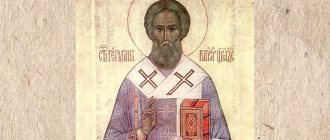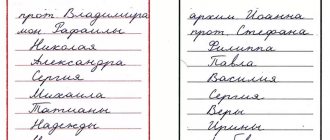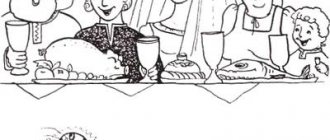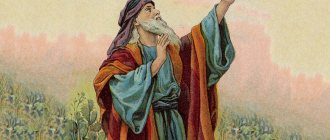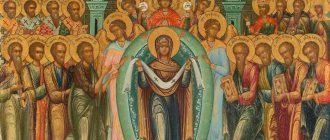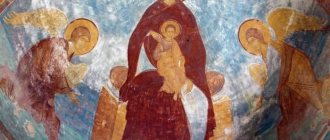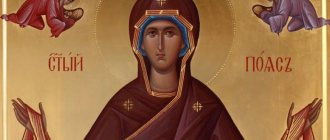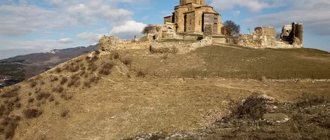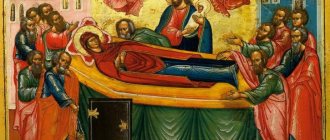The book “The Earthly Life of the Blessed Virgin Mary” was written by Sofya Ivanovna Snessoreva.
This is an interesting, although not very well-known figure in the Orthodox world. The fact that relatively little is said about her was also influenced by the writer’s lifestyle. She worked a lot, but preferred to publish her works anonymously.
And yet, Sofia Ivanovna’s last book brought her fame. Today this work has gone through more than one reprint, it is read on television and studied by linguists. Let's talk a little about the writer and her work.
Holy Mother of God
Mother of God, Mother of God, Queen of Heaven, Virgin Mary. This is not a complete list of the names of the earthly mother of the Lord Jesus Christ. She is the greatest of all saints and is revered even above the angels. The Most Holy Theotokos was a simple girl from the city of Nazareth. Being engaged to the pious carpenter Joseph, She remained a virgin devoted to God. The Virgin revealed in herself the receptacle of a special manifestation of His grace. Through the Holy Spirit, Mary miraculously conceived and gave birth to the Son of God, Jesus Christ (Luke 1:35).
“The virgin, by the power of Him who was in Her, gave birth naturally, but suffered nothing. The seal of virginity is not broken either by the conception of Christ or by birth” (“Creations of St. Ephraim the Syrian.” Volume 1).
Holy Mother of God
Mother of the Savior of the World
Christ combined two natures in himself: without ceasing to be God, He was the Perfect Man. He is called the Savior, because by His death and Resurrection the Lord atoned for the sins of mankind. And with His Ascension He opened the way to Heaven for us. When Christians are united with Christ in the Sacrament of Baptism, they are spiritually united with His Mother.
“She is a source, because living Water flowed out of her to the thirsty, and those who tasted this drink give a hundredfold fruit” (Creations of St. Ephraim the Syrian. Volume 3).
The Mother of God is repeatedly mentioned in the prophecies of the Old Testament. The most famous is what the prophet Isaiah said:
“Behold, the virgin will conceive and give birth to a Son, and they will call His name Immanuel” (Isaiah 7:14).
Emmanuel is one of the impersonal names of Christ, meaning “God with us.” It indicates the coming of the Savior to our world. Also in the Old Testament there are various prototypes of the Mother of God. For example, Jacob's ladder (Gen. 28:12-17) symbolizes the union of heaven and earth through the birth of Christ, and the Burning Bush (Ex. 3:2-5) symbolizes the virgin birth.
The Most Holy Theotokos was venerated by the first Christians. Her images were found in the Roman catacombs. Here the early Christians hid from persecution and performed divine services. The dogma of veneration of Mary as the Mother of God was consolidated by the Church at the Third Ecumenical Council (431). Of the 12 main church holidays (twenties), 4 are dedicated to the Mother of God: Her Nativity, Entry into the Temple, Annunciation and Dormition.
To understand the Christian tradition and the Divine image of the Mother of God itself, it is useful for every Christian to know the following truths: The Blessed Virgin Mary is in the literal sense the Mother of the Lord Jesus Christ and therefore the Mother of God; She remains the Ever-Virgin before the birth of Jesus Christ, at Christmas and after Christmas; The Mother of God follows the Savior as the highest power of all heavenly powers - the holy apostles and holy fathers of the church. The books of the Old and New Testaments, and the very earthly life of the Mother of God, lead to such a generalization.More than two thousand years separate us from the day when the Blessed Virgin was born into the light of God. Today it is difficult to even believe that She had an earthly life filled with human worries, joys and sufferings. We are accustomed to perceiving Her as the Queen of Heaven, but She had her own earthly character traits - a tendency towards peace and thoughtfulness, as evidenced by Her contemporaries. The divine touching smile of the Virgin Mary was forever captured by icon painters; it is not even a smile, but an image of kindness itself.
Mary’s mother’s name was Anna, her father’s name was Joachim, both family branches had venerable ancestors behind them, among whom were patriarchs, high priests and Jewish rulers from the branches of the wise Solomon and the mighty David. Joachim and Anna were not considered wealthy and noble, although they lived comfortably, raising large flocks of sheep. They were oppressed by only one sadness: there were no children. The coming of the Messiah was already predetermined, and childless people were obviously deprived of the hope of having the Messiah as their descendant, which every family secretly dreamed of. Among the Israelis at that time, even the clergy perceived a childless person as being punished from above. This is confirmed by a fact from the life of Joachim. On the feast of the renewal of the Temple of Jerusalem, he, along with other residents, brought rich gifts for the Temple, but the priest refused to accept them - Joachim’s childlessness was the reason for this. He bore his grief heavily, for some time he even retired to the desert, where, crying bitterly, he repeatedly turned to God: “My tears will be my food, and the desert will be my home until the great and wise Lord hears my prayer.” And then Joachim heard the words of the Angel of the Lord: “I was sent to tell you that your prayer has been heard.”
Your wife Anna will give birth to you a wonderful daughter, and you will name her Mary. Here is a confirmation of my words: when entering Jerusalem, behind the Golden Gates you will meet your wife Anna, and she will also delight you with joyful news. But remember that your daughter is the fruit of a divine gift.”
The Angel of the Lord also appeared to Anna and also told her that she would give birth to a blessed daughter. The small southern town of Nazareth, where Joachim and Anna lived, was located three days' journey from Jerusalem. From the very beginning of their life together, they walked from Nazareth to express their great request to God in the famous Temple in Jerusalem: to have a child. And now the dream came true, their joy knew no bounds.
On December 9 (Hereinafter in the biography the dates are given according to the old style.) the Orthodox Church celebrates the conception of the Blessed Virgin, and on September 8 - Her birth. At the age of three, Mary was brought into the Temple in Jerusalem. This was a very important moment; it is no coincidence that the Orthodox Church celebrates such an event. It took place in a very solemn atmosphere: the procession was opened by girls the same age as the Blessed Virgin, with lit candles in their hands, and behind them walked Joachim and Anna together with their blessed daughter, holding hands. They were followed by numerous relatives, among whom were very noble persons. Everyone's faces were lit up with joy. The virgins walked singing spiritual songs, their voices merging with the singing of the Angels.
The Blessed Virgin was destined to spend many years in the Temple of Jerusalem. That temple was the prototype of a monastic monastery. Within the walls of the Temple there were 90 separate spacious rooms-cells. A third of them were allocated to virgins who dedicated their lives to God, the remaining rooms were occupied by widows who gave dinner to remain celibate. The elders took care of the younger ones, taught them to read holy books and handicrafts. The Blessed Virgin Mary immediately surprised everyone by the fact that she easily comprehended the most difficult passages of the sacred books, better than all the adults who had studied these books all their lives.
After the birth of the desired child, the parents die very soon, first Joachim at the age of 80, then Anna. There was no one even to visit the little child staying in the Temple. Orphanhood and the consciousness of her loneliness turned Mary’s heart even more strongly to God, in Him was contained her entire destiny.
When Mary was fourteen years old, the high priests announced to her that the time had come to get married. Mary replied that she wanted to devote her life to God and wanted to preserve her virginity. What should I do?
The angel of the Lord appeared to the high priest Zechariah and told him the advice of the Most High: “Gather together the unmarried men of the tribe of Judah, from the family of David, let them bring their staves. And to whomever the Lord shows a sign, give the Virgin to him, so that he may become the guardian of Her virginity.”
That's exactly what happened. The High Priest Zechariah gathered unmarried men near the temple and turned to God with a prayer: “Lord God, show me a husband worthy of becoming the betrothed of the Virgin.” The staffs of the invited men were left in the sanctuary. When they came for them, they immediately saw how one staff blossomed, and a dove was sitting on the branches that appeared. The owner of the staff turned out to be 80-year-old widower Joseph, who was engaged in carpentry. The dove flew off the staff and began to circle above Joseph’s head. And then Zechariah said: “You will receive the Virgin and keep Her.” At first, Joseph objected, fearing that with adult sons older than Mary, he would become the laughing stock of people. Tradition says that Mary herself was very upset that She had to leave the Temple of God. But by the will of the Almighty, the betrothal took place, only Joseph became not the husband of Mary, in our usual understanding, but the guardian of holiness and a caring servant of the Virgin Mary.
Not much is said about Joseph in Scripture, but still, bit by bit, a fairly clear image can be formed. The elder was a descendant of kings David and Solomon, a man of firm and truthful character, modest, attentive, and hardworking. From his first marriage to Solomiya, he had two daughters and four sons. Before his engagement to Mary, he lived for many years in honest widowhood.
Joseph brought the God-given girl to his home in Nazareth, and they plunged into ordinary everyday affairs. Only Mary had a premonition of a great accomplishment, something indescribable, extraordinary. All people were waiting for the coming of the Messiah, as the only deliverer from numerous vices that entangled people like a web.
Luxurious Rome, which conquered many countries, indulged in pleasures, wallowed in debauchery, perversion, fanaticism, forgetting about all virtues. A catastrophe of the spirit always leads to a catastrophe of the body. Only the Almighty could be a healer of the spirit. And the Virgin Mary, as if instinctively, without realizing it, was preparing for the fulfillment of the greatest Divine plan. Her soul comprehended the birth of the Savior. She did not yet know in what way God would send His Son to Earth, but Her soul itself was already preparing for this meeting. Thus, the Most Holy Virgin of things, in Her essence, alone could unite the age-old foundations of the Old Testament with the new Christian laws of life.
To preach the gospel of His Divine plan, the Lord chose the Archangel Gabriel, one of the very first angels. The icon of the Annunciation (celebration of March 25) reveals to us this great act of the Lord. It depicts the quiet descent from heaven to Earth of an angel in the guise of a magnificent young man. He hands the Virgin Mary a heavenly flower - a lily and pronounces priceless words; “Rejoice, full of grace: the Lord is with you! Blessed are You among women!” The meaning of these heavenly words is that the Most Holy Virgin conceives a Son, whose kingdom will have no end. Before, She read the sacred books, in particular, the prophet Isaiah, that a certain Virgin would give birth to the Son of Man from God. She was ready to become a servant of That woman, and did not think about her own divine destiny.
Modern man can create doubt in his mind. The Immaculate Conception has raised questions throughout the ages. But the most amazing thing is that hearing the Good News first of all doubted Mary herself. “How will this happen to me when I don’t know my husband?” - were her first words.
A fact may indeed seem dubious if one comprehends it with a cold mind. But it must be accepted not with the mind, but with the soul. The Immaculate Conception or ever-virginity of the Most Holy Theotokos is a union of the heavenly and earthly, the spiritual and the material. That was the moment of the rebirth of a worldly person into Holiness, which people have been worshiping for two millennia.
Moscow Metropolitan St. Philaret (1782-1867) speaks heartfeltly and sublimely about this phenomenon: “The virgin is ready to become a mother, She bows before the Divine destiny, but does not want and cannot experience earthly marriage, this common path to birth on Earth... Alone This heart trembles with Divine love. Everything - all thoughts, feelings, aspirations - are given to the invisible, unapproachable God. He alone could be Her desired, Her imperishable groom. And at that moment, as they spoke to Her about the Son, Her purest soul, frightened by the mere possibility of the thought of earthly marriage, powerfully rushed there, into the heights, to the only desired and awaited God. And then the mysterious, wonderful, immaculate conception took place..."
Thus the words of the Archangel Gabriel were confirmed: “The Holy Spirit will come upon You, and the power of the Most High will overshadow You; therefore the One who is to be born is holy, and will be called the Son of God.”
Materialists cannot comprehend this miracle. Some accept only physics, others take a bolder step into metaphysics. But how natural and natural it is to recognize the Divine principle! Although the concept of “beginning” is applicable to a specific phenomenon, and God is Eternity, which cannot have a beginning and an end. God is the force that establishes harmony in the Universe.
The Annunciation icon helps mortal man to accept this spiritual essence and connects us with the Divine world. In Nazareth, where the Archangel Gabriel preached the gospel to the Virgin Mary, a temple was erected in the 4th century in memory of the Annunciation. Inextinguishable lamps burn in the altar, casting light on the words that contain the essence of the greatest sacrament: “Yic Verbum caro fuit” (“Here is the word flesh”). Above the throne is an image of the Annunciation and next to it are vases with white lilies. The flower that was in the hands of the Archangel Gabriel symbolizes purity.
According to tradition and the writings of the holy fathers of the church, the Good News made an indelible impression on the Blessed Virgin. She wanted to share this Divine news with her closest spiritual relative, Elizabeth, with whom she stayed for three months. Elizabeth was the first of mere mortals to believe in the immaculate conception of the Virgin Mary and exclaimed: “Blessed are You among women, and blessed is the fruit of Your womb.” This Divine fact is reflected many times in iconography and religious painting, as is the entire subsequent life of the Holy Family. And it was not without suffering.
One must imagine the state of the Virgin Mary, who must explain to her husband the reason for the already visible fruiting. The sublime and the sinful stood on the same scales in her imagination. A grave drama was brewing in the soul of earthly man. And what was the state of Joseph, who was in awe of Mary, but saw changes in Her figure and suffered from questions that tormented him?! Of course, the Virgin Mary could tell Joseph everything as it happened... But would he believe that the Divine fruit was hidden in Her womb? And how can we speak of ourselves as holiness? The Virgin Mary preferred silent suffering to all such supposed explanations, questions and answers. After all, She was aware of the fact of the ascension of mortal man to an unattainable height.
Righteous Joseph, not knowing the secret of the Lord’s incarnation, showed extraordinary kindness. After much torment, various assumptions and hesitations, he decides to secretly present the Virgin Mary with a letter of divorce without indicating the reason for the divorce. Saint John Chrysostom explains this act this way: “Joseph showed amazing wisdom in this case: he did not accuse or reproach the Virgin, but thought only to let Her go.” He really wanted to preserve the honor of the Virgin and save Her from persecution by the law, thereby satisfying the demands of his conscience. And just as he decided to carry out his plan with the letter, an angel of the Lord appeared to him in a dream. All contradictions and omissions were instantly resolved by the Lord's revelation.
The Nativity of Christ and His entire subsequent earthly life are most fully and variedly represented in spiritual literature, in icon painting. Over the course of two millennia, a number of books have been written about it that cannot be counted in the usual circulations. There was no other similar life on Earth that would attract human souls with such unshakable force. Over the course of a gigantic period of time (in the usual human understanding), the burning of lamps and candles did not stop in honor of Jesus Christ on Earth. If black forces blew up the temple of God, then a candle burned in some hut. If it went out in one part of the world, it invariably shone with flame in front of a pure image in another. At all times, the great spiritual feat of Christ, which all people in the world must know about, remained the highest ideal of service to God the Father and service of God the Son to humanity. The life of Jesus Christ was a living example of fulfilling the two first biblical commandments: to love God and to love your neighbor.
Failure to observe these commandments by humanity leads to destruction. Life has convinced us of this more than once. Evil seems to migrate across the planet in time. History records: the obscurantism of pagans of various stripes, the ferocity of the Herodian dynasty, the cruelty of Nero, the fanaticism of the Jesuits, the harmful consequences of the doctrines of philosophers like Nietzsche, the deception of false prophets and the disastrous temptations of the new “kings” and so-called democracy. Where the commandments of the Lord are not kept, evil invades, lies flourish there, and faith in God becomes false; where the commandments of Christ the Savior are not observed, there is constant bloodshed, and love for one’s neighbor is manifested only in words; where the commandments of the Almighty are not observed, there the government is luxurious, and the people are poor. Such a society is doomed to destruction.
If we imagine that Jesus Christ had not come to earth, then there would have been no force at all to counteract evil, and humanity would have ended its existence long ago. The Savior appeared on earth during the reign of King Herod. It is clear what people associate with this name. At all times and to this day, the most vile rulers are called Herods. Whoever opposes them follows the commandments of Christ.
At all stages of the spiritual feat of Jesus Christ himself in the name of saving people, His Mother, the Most Holy Theotokos, stood next to Him. She bore her cross with the greatest earthly dignity. On a cold night, She, having given birth to a son, could not shelter Him in Her house (“She gave birth to Her firstborn son, and wrapped Him in swaddling clothes, and laid Him in a manger, because there was no room for them in the inn”) Lk. 2:7." King Herod, who unrighteously commanded the people, was very afraid of the coming of the Messiah; he in every possible way prevented the fulfillment of God’s intentions. Having learned about the birth of Christ, he committed a terrible, barbaric crime - he ordered to kill all the babies in Bethlehem and its environs, hoping that among those killed would be the newborn King of the Jews - the Savior. 14,000 innocent children - boys - fell as sacrifices for Christ by the will of King Herod. What fear did the Mother of God feel for the life of her Son?!
She experienced every second of Jesus' life, from birth to crucifixion and ascension. And one must imagine Her grief, how it shook the soul when the ignorant crowd mocked the Holiness, when the blood froze on the forehead of Her Son from the crown of thorns and when the Most Pure Body of Jesus had to be removed from the cross...
After the Ascension of Christ, the earthly path of the Mother of God was still quite long and fruitful.
She was destined, together with the apostles, to carry the teachings of Christ throughout the world. Rejoicing at the successes of the Son’s disciples, the Mother of God herself almost never spoke before the people. However, there is one wonderful exception in the legends... More on that later. The Mother of God sought the essence of Christian teaching not in words, but in life itself. By the way, this is the most effective method of teaching children by parents: you can say little and do a lot, then children will definitely understand how to do and what to do. The Virgin Mary diligently served the poor, gave to the poor, cared for the sick, and helped orphans and widows. She devoted a lot of time to prayers at the tomb of her Son. The Virgin Mary buried Joseph the betrothed when Jesus was in adolescence. Joseph also modestly and nobly fulfilled his life’s feat. The life of each of us should be a feat; the essence of life lies in fulfilling with dignity the destiny given by God to each person. How to do it? Follow your conscience. Conscience should be the guide of life—presented by God, guarded by man. With her existence, material and spiritual efforts, the Mother of God taught people how to live, awakening in man Conscience - the voice of God. The Mother of God - the Mother of God, standing in front of the icon - Her image, a person opens his soul, trusts secrets, sends repentance for sins, hoping for Her mercy and mediation before God. And the Mother of God connects a particle of this Divine principle in man with the Almighty.
The laconic Virgin Mary once nevertheless had to speak to people with a most wonderful sermon, the legend of which has survived to this day. The Mother of God intended to visit Cyprus.
The ship crossed the Mediterranean Sea, and the desired island was about to appear. But suddenly a storm hit the ship, and it became uncontrollable, it was carried to the other side of the world, as if by the will of the heavenly Helmsman. The ship fell into the Aegean Sea, rushed between numerous islands and stopped by the will of the Almighty at the foot of Mount Athos. That area was literally teeming with idolatry temples with a huge temple of Apollo in the center, where various fortune-telling and pagan sorcery were performed.
But then the Mother of God descended from the ship to earth, and people began to flock to Her from everywhere with questions: who is Christ and what did He bring to Earth? And then She was forced to tell people for a long time about the mystery of the incarnation of Jesus Christ, about the suffering that befell Him for the sins of people, about execution, death, resurrection and ascension to heaven.
She revealed to people the essence of the teachings of Jesus Christ - about repentance, forgiveness, love for God and neighbor - as great values that affirm goodness, justice and prosperity in the world.
After such a heartfelt sermon of the Mother of God, an extraordinary action took place. Everyone who heard Her wished to be baptized. Leaving Athos, the Mother of God blessed the newly converted Christians and made a prophecy: “Let this place be my lot, given to me by My Son and My God. May My grace rest upon those who live here with faith and piety and keep the commandments of My Son and God. They will have in abundance and with little difficulty everything necessary for earthly life, and the mercy of My Son towards them will not fail. Until the end of the age I will be the Intercessor of this place and the intercessor for it before My God.”
The further history of Athos to this day confirms that Divine protection has been felt and materialized over that place in all centuries.
The blessings of the Mother of God similar to those of Athos are so endless that a whole chronicle can be compiled from them. Many icons of the Mother of God are dedicated to this. There is a story about them ahead. Towards the end of her earthly life, the Mother of God strove with all Her being towards Heaven. And one day, during prayer, the Archangel Gabriel appeared to Her again with a joyful and radiant face, just as decades ago, when he brought the Good News from the Almighty. This time the news was that the Mother of God had only three days left to remain on Earth. With the same great joy, She accepted this message, for there could be no greater happiness for Her than to eternally contemplate the image of Her Divine Son. Archangel Gabriel handed Her a heavenly date branch that emitted extraordinary light day and night. The Mother of God was the first to tell the Apostle John about the appearance of the Archangel Gabriel, who almost never separated from the Mother of God.
Having notified everyone at home about her upcoming departure from the sinful Earth, the Mother of God ordered to prepare Her chambers accordingly: decorate the walls and bed, burn incense, light candles. She exhorted her loved ones not to cry, but rather to rejoice in the fact that, talking with Her Son, She would direct His goodness to everyone living on Earth, and would visit and protect those in need.
Apostles and disciples from all over the world, alerted by the Holy Spirit, gathered in a miraculous manner to see off the Mother of God on her final journey. There were about seventy of them - the most devoted preachers of the teachings of Christ. On the blessed 15th day of August and the third hour from noon, everyone gathered in the temple, decorated especially for the sacred unprecedented action. Many candles were burning, the Mother of God was reclining on a splendidly decorated bed and praying selflessly in anticipation of her outcome and the coming of Her Son and Lord. According to legend, one can imagine an extraordinary picture.
At the appointed time, the entire temple was bathed in a never-before-seen heavenly solemn light. It was as if the walls parted and the King of Glory Christ Himself ascended above the heads of people, surrounded by a host of angels, archangels and other disembodied forces, with the righteous souls of the forefathers and prophets.
Rising from her bed, the Mother of God bowed to Her Son and the Lord with the words: “My soul magnifies the Lord, and My spirit rejoices in God My Savior, for He has looked upon the humility of His servant!.. My heart is ready; Wake Me according to Your word..."
Looking at the radiant face of the Lord, Her dearest Son, without the slightest bodily suffering, as if sweetly falling asleep, the Mother of God transferred Her most radiant and pure soul into His hands.
Metropolitan of Moscow Saint Philaret, in his letters on the veneration of the Most Holy Theotokos (M. 1844), explains to his compatriots this solemn moment of transition from earthly life to the life of the eternal Virgin Mary: “And since the Ever-Virgin carried the Son of God in Her arms during His earthly infancy, then, as reward for this, the Son of God carries Her soul in His arms, at the beginning of Her heavenly life.”
The body of the Virgin Mary was buried on earth. Saints Peter and Paul, with the Lord's brother Saint James and the other apostles, lifted the bed onto their shoulders and carried it from Zion through Jerusalem to the village of Gethsemane. Saint John the Theologian carried before the bed a paradise date branch presented to the Virgin Mary by the Archangel Gabriel. The branch shone with heavenly light. Above the entire crowded procession and the most pure body of the Mother of God, a certain cloudy circle suddenly appeared - something like a crown. And the joyful singing of the heavenly forces spilled into space. Radiance and Divine chants accompanied the procession until the burial.
Tradition testifies to how the unbelieving inhabitants of Jerusalem, amazed by the extraordinary grandeur of the funeral procession and embittered by the honors given to the Mother of Jesus Christ, reported what they saw to the Pharisees. Their order followed: destroy the entire procession and burn the coffin with Mary’s body! But a miracle happened: a shining crown - the Divine sphere, covered the procession like a protective cap. The soldiers heard the footsteps of people accompanying the Mother of God, heard singing, but could not see anyone. They bumped into each other, into houses and fences, and felt as if they were blind. Nothing could interfere with the solemn burial.
Nowhere in Holy Scripture will we find a narrative about the death of the Virgin Mary. There was no death. Of course, in the understanding of how it happens to an ordinary person, when the body is given over to the earth and the soul to God. The Holy Orthodox Church calls the departure of the Mother of God from earthly life the Assumption. And he sings the Dormition of the Mother of God like this: “The laws of nature are defeated in You, O pure Virgin, virginity is preserved at birth and life is combined with death: remaining a Virgin through birth and living after death, You will always save, Mother of God, Your inheritance.”
The Dormition means that the Virgin Mary, after a difficult many-year wakefulness, fell asleep in a sweet sleep, reposed to the eternal source of life, becoming the Mother of Life, delivering with Her prayers the souls of mortals from torment and death, instilling in them with Her Dormition a living foretaste of eternal life.
The Apostle Thomas, as the legend says, arrived in Gethsemane only on the third day after the burial of the Most Holy Theotokos. He grieved and cried a lot over this and really regretted that he was not awarded Her blessing. And then the other apostles allowed him to open the coffin to make a final farewell. The stone was rolled away, the coffin was opened, but... the body of the Virgin Mary was not there. The apostles began to pray to the Lord that He would reveal His secret to them.
In the evening the holy apostles sat down to a meal. As was customary among them, they left one place unoccupied, and placed a piece of bread in front of it, so that after the meal, giving thanks to the Lord, glorifying the name of the Holy Trinity, this piece of bread could be tasted by everyone as a blessed gift with the prayer: “Lord Jesus Christ.” , help us!” Everyone thought and talked during the meal only about the miraculous disappearance of the body of the Mother of God. The meal was over, everyone stood up and, as usual, raised the bread set aside in honor of the Lord... Looking up, preparing for prayer, everyone saw the Most Pure Virgin Mary, surrounded by many angels. And they heard from Her: “Rejoice! I am with you all the days!”
The entire earthly life of the Mother of God fits into a specific 72 years, this is evidenced by the calculations of the ancient holy fathers of the church (St. Andrew, Archbishop of Crete, St. Simeon Metaphrastus), authoritative church historians agree with them. But from the entire holy life of the Blessed Virgin, the Orthodox Church has identified four most important spiritual events, celebrated by great holidays: the Nativity of the Mother of God, the Entry into the Temple, the Annunciation and the Dormition. These holidays are counted among the so-called twelve and are equated to the great holidays of the Lord. There are twelve of them in total per year. Behind every holiday there is a great spiritual event, the reflection of which is an endless number of icons.
But at the same time, the icons of the Most Holy Theotokos themselves have a special life, a special history, they preserve miracles and still have a beneficial effect on people.
Before interpreting the icons of the Most Holy Theotokos, it will be interesting and useful to imagine Her earthly appearance according to the descriptions of eyewitnesses that have come down to us in the sacred books. But the main feature of the Blessed Virgin, which determines all of Her spiritual content, was defined by Saint Gregory of Neocaesarea as follows: “She has a mind controlled by God and directed towards God alone.” All of Her contemporaries, without exception, place the impeccable spiritual qualities of the Mother of God in the foreground.
Saint Ambrose, in the guise of the Mother of God, notices those features that can serve as an ideal person: “She was not eloquent, a lover of reading... Her rule was not to offend anyone, to be kind to everyone, to honor elders, not to envy equals, to avoid boasting, to be sensible, to love virtue . When did She offend her parents even with her facial expression? When did you disagree with your family? When did you become proud in front of a modest person, laugh at the weak, shy away from the poor? She had nothing stern in her eyes, nothing imprudent in her words, nothing indecent in her actions: her body movements were modest, her step was quiet, her voice was even; so Her bodily appearance was an expression of the soul, the personification of purity.”
Saint Dionysius the Areopagite, three years after his conversion to Christianity, was privileged to see the Blessed Virgin Mary face to face in Jerusalem, describes this meeting as follows: “When I was brought before the face of the God-like bright Virgin, such a great and immeasurable Divine light enveloped me from without and within. and such a wonderful fragrance of various aromas spread around me that neither my weak body nor my spirit itself were able to bear such great and abundant signs and firstfruits of eternal bliss and glory.”
Saint Ignatius the God-Bearer surprisingly accurately defines the essence of the blessed influence of the Mother of God on mere mortal people: “In Her the angelic nature was united with the human.”
From the legends and memories of contemporaries of the Blessed Virgin, a completely visible image emerges. The church historian Nicephorus Callistus verbally depicted him this way: “She was of average height, golden hair, quick eyes, with pupils as if the color of an olive, arched and moderately black eyebrows, an elongated nose, flowering lips, full of sweet speeches; the face is not round or sharp, but somewhat oblong, the arms and fingers are long.”
At all times, the holy fathers of the church expressed their genuine delight before the image of our Most Pure Theotokos, Ever-Virgin Mary. For example, the great theologian of the Orthodox Church, Saint John of Damascus (VII century), says: “God, the highest and purest light, loved her so much that through the invasion of the Holy Spirit he was essentially united with Her, and was born from Her as a perfect man, without changing or mixing his properties. "
It is these properties, specifically defined and named by the venerable chroniclers of the church, the holy fathers and contemporaries of the Virgin Mary, that are present in every icon of the Mother of God, corresponding to one or another event in Her life, one or another feast of the Mother of God, one or another phenomenon associated with Her.
The first icon painter who left the most accurate image of the Mother of God was the disciple of the Apostle Paul and his assistant, the holy evangelist Luke. Pious believers wished to see the face of the Mother of God. Saint Luke paints an image of the Virgin Mary and presents it to Her directly. Having seen the first icon of the Mother of God, or rather her own image, she involuntarily said: “May the grace of the one born of Me and Mine be with this icon!” Her blessing made the icons of the Mother of God blessed - giving the believer good, deliverance from vice, filling the soul with divine light.
The history of the first icon is unique. She spent many years in Antioch, where believers first called themselves Christians. Next, the holy image moves to Jerusalem, and then ends up in Constantinople to the holy queen Pulcheria (in the middle of the first millennium). Together with their husband Emperor Marcian, they erected three magnificent temples in Constantinople in honor of the Mother of God - Chalkopratea, Odigitria and Blachernae. In the temple of Hodegetria they place an icon painted by the holy evangelist Luke.
The Mother of God in the fate of Russia is like a mother for a baby. There is a special mystery in the veneration of the Mother of God by Russian people. It lies in the hope of omnipotent maternal intercession before God. After all, the Almighty is not only a great benefactor, but also a formidable judge. Russians, who have such a valuable character trait as repentance, have always had fear of God side by side with love of God. Like his own mother, a God-fearing sinner asks for the protection of the Mother of God, going to the judgment of the Lord. A person knows his sins; that is why God has given him a conscience. The great Intercessor, Defender, Savior - the Mother of God - helps us to hold ourselves accountable to God for our sins. It seems to soften the punishment, but it reveals a person’s conscience. When the poet says that “you can’t understand Russia with your mind,” he means Conscience. The Russians entrusted this vulnerable and completely non-material “structure” - the divine essence - to the Mother of God.
There is no more illustrious name in Rus' than the Most Holy Lady and Ever-Virgin Mary. From the very beginning of Russian history, the main cathedral churches have been dedicated to the Mother of God. Byzantine craftsmen erected the Assumption Cathedral in the Kiev Pechersk Lavra at the command of the Mother of God Herself. The desire of the Mother of God to remain in Rus' is attested in the Kiev-Pechersk Patericon. And since then, people in Rus' began to consider their Fatherland as the House of the Most Holy Theotokos.
The veneration of the Mother of God is accomplished primarily through icons. In the church calendar alone there are about three hundred venerated icons of the Mother of God. Each has its own name. There is almost no day in the year that this day is not illuminated by the celebration of one or another icon of the Mother of God.
The outcome of great historical events is associated with the miraculous influence of the icons of the Mother of God. The Don Icon helped in the Battle of Kulikovo; in the salvation of Moscow from Tamerlane and during the great stand on the Ugra - Vladimirskaya; in the Time of Troubles during the expulsion of the Poles from Moscow - Kazan; with the establishment of the ruling Romanov dynasty - Feodorovskaya; in the Battle of Poltava - Kaplunovskaya. In 1917, on the day of the abdication of the martyr Tsar Nicholas II from the throne, it was as if the Mother of God Herself, unexpectedly appearing in the form of the Sovereign, took upon herself the succession of power of the Russian Power. But many people did not preserve this holy image, nor did they preserve themselves.
For Russian people, the saving quality of the Mother of God has always been revered as the blessing of one’s own mother. The people entrusted their souls and all of themselves to the Mother of God. The icons of the Mother of God were treated as living shrines, and therefore they were often given their own names, just like a person.
__
Orthodox online distance learning course (free)
We recommend taking this course to all beginning Orthodox Christians. Online training takes place twice a year, sign up for the next courses today!
The first Orthodox radio in the FM range!
You can listen in the car, at the dacha, wherever you do not have access to Orthodox literature or other materials.
The Most Holy Theotokos: earthly life before the Annunciation
In the New Testament, the Mother of God is called only Mary and is mentioned sporadically. The Life of the Most Holy Theotokos is based largely on Church Tradition, namely on the early Christian apocrypha.
Mary was born into the family of the holy righteous Joachim and Anna. They were pious people, but until old age they had no children. Childlessness was condemned in Old Testament society and was considered a punishment from above. The couple fervently prayed to God for the gift of a child. They promised that they would devote his life to serving the Almighty. The prayers of Joachim and Anna were heard - they had a daughter. They named her Mary, which means “lady” or “hope.”
When the girl turned three years old, it was necessary to perform a traditional rite of dedication to God. Mary was led to the temple. And She independently, without turning around, ran up its steep steps, which amazed everyone around her. The future father of John the Baptist, High Priest Zacharias, came out to meet Her. By God’s inspiration, he led Mary into the Holy of Holies, the main place in the temple. Outsiders were strictly forbidden to enter here, and even the high priest could only enter once a year. After this, the parents of the Mother of God left their daughter at the temple. Here she studied and worked with other girls.
At the age of 12, Mary was supposed to leave the temple and get married. But She told the priests that she had made a vow of virginity to God. The adults respected her choice. Maria's parents had died by that time. Therefore, it was decided that the elderly carpenter Joseph would take care of and protect her. God himself miraculously pointed it out to the priests. The future Most Holy Theotokos lived with Joseph in Nazareth and spent her time in needlework and prayer. Joseph was for Mary only a betrothed, formal husband. They did not enter into ordinary marital relations.
Sofya Ivanovna, the author of the book, received an excellent education
Sofya Ivanovna was born in 1815 in Voronezh. Her family had six sisters and brothers. Some are adopted.
As the eldest son, a seminarian-theologian lived in the house, who greatly influenced Sofya Ivanovna. He taught his sisters and brothers various sciences: algebra, geometry, Latin.
Snessoreva Sophia is the author of the book “The Earthly Life of the Blessed Virgin Mary”
In the future, Sofia Ivanovna’s education also turned out well. She was sent to the Noble boarding school of Mrs. Dnepr. This place gave the future writer the knowledge that helped her throughout her subsequent life.
It cannot be said that studying was without difficulties. But it was precisely the severe demands of the teachers that allowed Sofya Ivanovna to strengthen her spirit and prepare for the tests that lay ahead.
In 1832 his father died. Without a breadwinner, the mother felt very difficult with nine children in her arms. And only four years later Sofya Ivanovna found a worthy husband, whose intelligence delighted her. She moved with him to St. Petersburg.
Subsequently, she noted that intelligence alone was not enough to find one’s place among fierce competition, and it took fortitude from both to survive hardships.
Birth of Christ
One day the Archangel Gabriel appeared to Mary. He announced that without physical intimacy with a man, the Holy Spirit, She would give birth to the Son of God (Luke 1:26-28), the Savior whom humanity has been waiting for since the Fall. Mary humbly agreed with God's will. This event is called the Annunciation. Venerable Nilus of Sinai in his “Letter to Deacon Priscillian” indicates that
“The conception of the Savior in the flesh of the Virgin was completely unloving, immaculate, undefiled, blameless, pure and uncorrupted.”
After some time, Joseph noticed that the girl was pregnant and was embarrassed by this. But an angel in a dream revealed to him the great destiny of Mary. Joseph submitted to God's providence and continued to protect the future Mother of God (Matthew 1:18-25).
At the dawn of Christianity, Judea was part of the Roman Empire. Shortly before Mary gave birth, the emperor began to conduct a population census in those lands. To participate, the Jews had to return to the cities where their family came from. For Joseph and Mary (descendants of David) it was Bethlehem. Arriving in the city, they could not find a free hotel. Joseph and Mary were forced to stop in a cattle pen, which served as a cave. This is where Jesus Christ was born. Magi and shepherds came to this cave to worship the Infant God.
Jesus was given his name on the eighth day after his birth during the ceremony of circumcision. After 40 days, the baby was brought to the temple for a cleansing sacrifice. This event is called the Meeting of the Lord. The ruler of Judea, Herod, knew about the Old Testament prophecies about the Son of God. Thus, Herod saw Christ as a personal threat. He decided to kill the Infant God. Warned by an angel, Mary and Joseph were forced to flee with their son to Egypt (Matthew 2:13). They returned to their homeland only after the death of Herod.
Life with Christ
The Holy Family settled and lived in Nazareth. Mary continued to do needlework and prayer. Jesus learned his father's trade and after his death he supported himself and his mother by carpentry. Ten years after coming of age, Christ began his ministry and began to preach. The Most Holy Theotokos followed him along with the apostles.
After fasting for forty days in the desert, Christ came with his Mother to a wedding feast in Cana of Galilee. It was here, at the request of the Mother of God, that the Savior first revealed his Divine power to people. Christ turned water into wine, which the feasters lacked (John 2:1-11). Soon after this, Mary moved to Capernaum.
When Christ was crucified on the cross, the Mother of God shared His suffering. She was not far from the place of execution along with the Apostle John, the Savior’s favorite disciple. At the direction of Christ dying on the cross, John cared for Mary from that day on (John 19:26-27). The Lord appeared to the Mother immediately after his Resurrection. Before this, an angel informed Her and Mary Magdalene about the rise of Christ from the dead. The Mother of God was also present at the Ascension of the Lord.
It was difficult to find work in St. Petersburg; in addition, I had to leave the city due to consumption
In St. Petersburg, Sofya Ivanovna is trying to use the knowledge she received at home to earn money. She takes on translations.
The working conditions are strict: three mistakes and you don’t get paid for the page.
Her first work was participation in the Russian edition of the “Plushar Encyclopedic Dictionary”.
But Sofya Ivanovna did not give up and continued to work. Over time, people notice her and order her new translations. Things seemed to be getting better, but due to consumption, the translator was unable to continue working.
At the insistence of the doctor, the family gave up everything and moved to a warmer climate - to Astrakhan. An emotional four years lay ahead: the death of her children and husband.
The Blessed Virgin Mary after the Ascension of Christ
The Most Holy Theotokos and the disciples of Christ stayed in Jerusalem after the Ascension. There the miracle of the descent of the Holy Spirit happened to them. He rested on the Mother of God and Christ's disciples in the form of tongues of flame (Acts 2:1-4). So the apostles and Mary received the gift of preaching and miracles, which glorified them throughout the world.
The Mother of God was for the apostles a living memory of their Teacher. Soon persecution began against the followers of Christ. The Mother of God and the apostles left Jerusalem and, using lots, chose places for preaching. According to Tradition, Mary fell to Iveria (Georgia). However, the angel told the Mother of God to remain in Jerusalem and later go to enlighten other lands. The Mother of God often visited the Holy Sepulcher and prayed there, each time miraculously escaping persecution.
Soon Mary went on a sea voyage to Cyprus to visit Bishop Lazarus, who had once been resurrected by Christ. But a storm brought Her ship to Mount Athos. This was the land where She was to preach. The Mother of God converted local pagan tribes to Christianity and blessed Athos. Next She visited Cyprus and Ephesus. And in the end she returned to Jerusalem, where the Archangel Gabriel informed Her of her imminent death.
Dormition of the Blessed Virgin Mary
The earthly life of the Mother of God ended in the middle of the first century AD. The Mother of God reposed in old age, surrounded by the apostles. The Lord miraculously transported them to Her deathbed from different parts of the world.
Why is the death of the Mother of God called the Assumption? This word does not simply mean the physical death of the Virgin Mary. This is the end of Her earthly service and the mysterious transition to heavenly service in Eternity, to her Son. This is not a sad, but a joyful and solemn event. Therefore, for Christians, the Dormition of the Blessed Virgin Mary is a great holiday.
Thomas was the only one of the apostles who was not present at the Dormition of the Mother of God. He joined the other disciples of Christ only on the third day after the death of the Virgin Mary. Thomas was very sorry that he did not have time to say goodbye to Her. The apostle asked to roll away the stone of the burial cave in order to say goodbye to the body of the deceased. But there was no body in the cave. There lay only the fragrant clothes of the Virgin Mary. The Church believes that the Virgin Mary was resurrected and taken to heaven.
Saint Ignatius Brianchaninov in his work “Exposition of the Teaching of the Orthodox Church about the Mother of God” wrote:
“On the third day, after Her blessed Dormition, the Mother of God rose from the dead and now lives in heaven, soul and body. She not only lives in heaven, She reigns in heaven... She has been given special power and special boldness to intercede before God on behalf of humanity.”
Venerable Nicodemus the Holy One calls:
“When you see the icon of the Most Holy Theotokos, turn your heart to Her, the Queen of Heaven, and thank Her for the fact that She appeared so ready to submit to the will of God, that she gave birth, “nourished” and raised the Savior of the world, and that in our invisible battle Her intercession and help to us never fails.”
Sofya Ivanovna became a permanent translator for the editor O.I. Senkovsky
Sofya Ivanovna never lost faith. And then there were improvements in health. She began giving lessons. I had to travel a lot around the city and beyond to visit students, for which the sick woman got up at five in the morning.
In 1848, Sofya Ivanovna was hired as a translator by the talented editor O. I. Senkovsky. He was a professional in his field.
Sofya Ivanovna had to get up at five in the morning to get to her students.
It was not difficult to work with him. But there were texts that Sofia Ivanovna did not like. But she was content with what she had - French articles. The translations were published in the magazine.
After Senkovsky's death, Sofya Ivanovna worked in many other publishing houses, translating small articles. There were also novels.
There was a demand for translators from German. And Sofya Ivanovna quickly changed her “profile” - she quickly learned German and took up Gerstecker’s major novel “To America”. After 8 months, the 800-page work was already published in Russian.
Prayers to the Blessed Virgin Mary
Virgin Mary, rejoice
Virgin Mary, Rejoice, Blessed Mary, the Lord is with You, blessed are You among women, and blessed is the fruit of Your womb, for You have given birth to our Savior.
Translation: Mother of God Virgin Mary, filled with the grace of God, rejoice! The Lord is with You; Blessed are You among women and blessed is the fruit born of You, because You gave birth to the Savior of our souls.
Worthy to eat
It is worthy to eat as truly the blessedness of Thee, the Mother of God, the Ever-Blessed and Most Immaculate and the Mother of our God. The most honorable cherub and the most glorious without comparison seraphim, without corruption of God the Word, who gave birth to the real Mother of God, we magnify Thee.
Translation: It is truly right to please You, Mother of God, eternally blessed and immaculate, and Mother of our God. You are superior in honor to the cherubim and in your glory incomparably higher than the seraphim. You virginally gave birth to God the Word, and as the true Mother of God we magnify You.
To my queen, offering
My Most Blessed Queen, My Hope, Mother of God, Friend of the Orphan and Strange to the Representative, the Sorrowful to Joy, the Offended to the Patroness! See my misfortune, see my sorrow; Help me, for I am weak; feed me, for I am strange! Resolve my grievance, as if I were wrong: for I have no other help than You, no other Representative, no good Comforter, except You, O Mother of God! May you protect me and protect me forever and ever. Amen.
Translation: My most blessed Queen, my Hope, Mother of God, shelter of orphans and protector of wanderers, joy of the grieving, patroness of the offended! You see my misfortune, you see my sorrow; help me as a weak person, guide me as a stranger. You know my offense: resolve it according to Your will. For I have no other help than You, no other Protector, no good Comforter - only You, O Mother of God: may you preserve me and protect me forever and ever. Amen.
Kontakion to the Blessed Virgin Mary
We are not the imams of other help, / are not the imams of other hope, / do You, O Lady, / help us, / we hope in you / and we boast in you, / / For we are your servants, let us not be ashamed.
Translation: We have no other help, / we have no other hope, / except You, Lady. / Help us: / we hope in You / and we boast in You, / for we are Your servants, / let us not be ashamed.
Read us conveniently on social networks:
Tags: life of the Mother of God, life of the Blessed Virgin Mary, earthly life of the Blessed Virgin Mary, Blessed Virgin Mary, holy Mother of God
